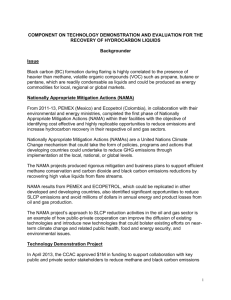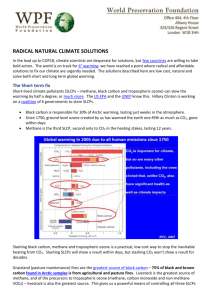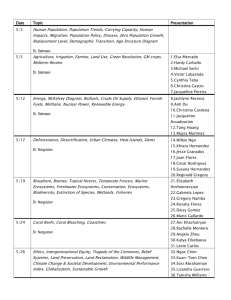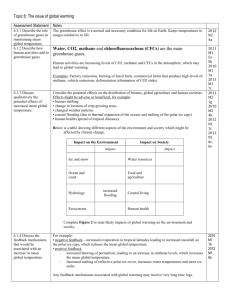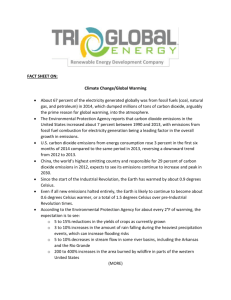wg_07 - The Renewable Energy Programme, Nigeria
advertisement
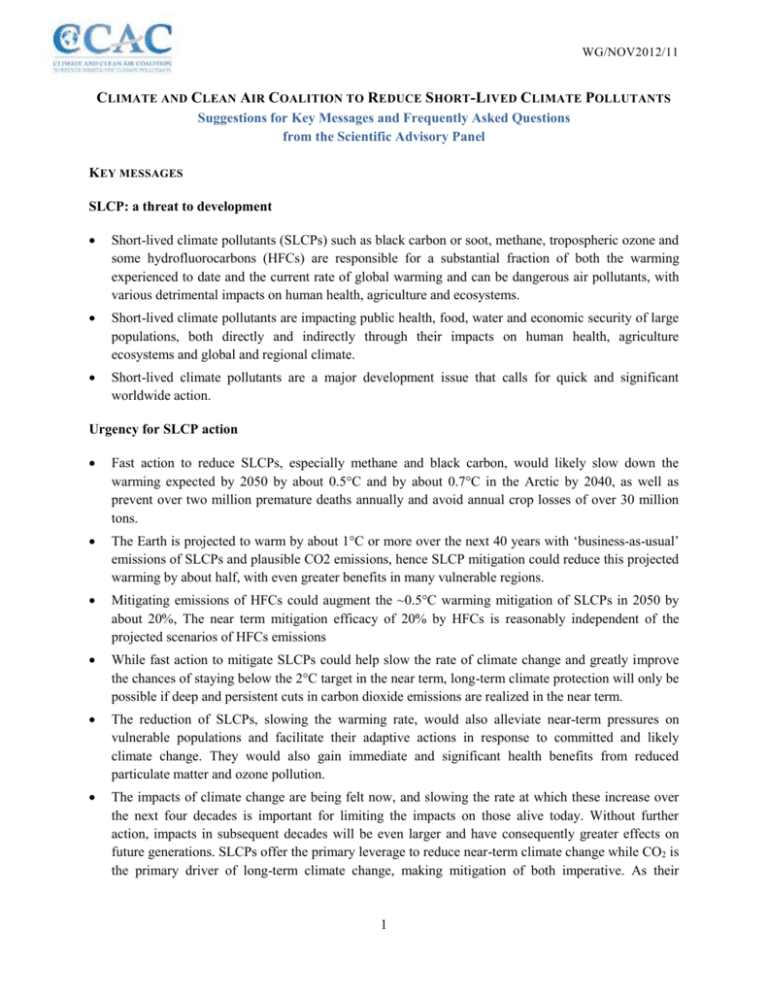
WG/NOV2012/11 CLIMATE AND CLEAN AIR COALITION TO REDUCE SHORT-LIVED CLIMATE POLLUTANTS Suggestions for Key Messages and Frequently Asked Questions from the Scientific Advisory Panel KEY MESSAGES SLCP: a threat to development Short-lived climate pollutants (SLCPs) such as black carbon or soot, methane, tropospheric ozone and some hydrofluorocarbons (HFCs) are responsible for a substantial fraction of both the warming experienced to date and the current rate of global warming and can be dangerous air pollutants, with various detrimental impacts on human health, agriculture and ecosystems. Short-lived climate pollutants are impacting public health, food, water and economic security of large populations, both directly and indirectly through their impacts on human health, agriculture ecosystems and global and regional climate. Short-lived climate pollutants are a major development issue that calls for quick and significant worldwide action. Urgency for SLCP action Fast action to reduce SLCPs, especially methane and black carbon, would likely slow down the warming expected by 2050 by about 0.5°C and by about 0.7°C in the Arctic by 2040, as well as prevent over two million premature deaths annually and avoid annual crop losses of over 30 million tons. The Earth is projected to warm by about 1°C or more over the next 40 years with ‘business-as-usual’ emissions of SLCPs and plausible CO2 emissions, hence SLCP mitigation could reduce this projected warming by about half, with even greater benefits in many vulnerable regions. Mitigating emissions of HFCs could augment the ~0.5°C warming mitigation of SLCPs in 2050 by about 20%, The near term mitigation efficacy of 20% by HFCs is reasonably independent of the projected scenarios of HFCs emissions While fast action to mitigate SLCPs could help slow the rate of climate change and greatly improve the chances of staying below the 2°C target in the near term, long-term climate protection will only be possible if deep and persistent cuts in carbon dioxide emissions are realized in the near term. The reduction of SLCPs, slowing the warming rate, would also alleviate near-term pressures on vulnerable populations and facilitate their adaptive actions in response to committed and likely climate change. They would also gain immediate and significant health benefits from reduced particulate matter and ozone pollution. The impacts of climate change are being felt now, and slowing the rate at which these increase over the next four decades is important for limiting the impacts on those alive today. Without further action, impacts in subsequent decades will be even larger and have consequently greater effects on future generations. SLCPs offer the primary leverage to reduce near-term climate change while CO2 is the primary driver of long-term climate change, making mitigation of both imperative. As their 1 WG/NOV2012/11 emissions are often from separate sources and their impacts occur on different timescales, policies to limit emissions of SLCPs and CO2 are typically quite distinct. Opportunities for SLCP action There are many cost-effective readily available options for addressing SLCPs, like preventing black carbon emissions from diesel engines and brick kilns, harnessing methane from landfills as a source of energy, and using new technologies to avoid use of HFCs with high global warming potential. Fast and sustainable action on SLCPs is a quick win which can make a significant contribution to internationally agreed development goals, including the Millennium Development Goals, in diverse sectors including health, energy, agriculture and transport in rural and urban areas. The CCAC: A new transformative initiative Recognizing that the SLCP issue and potential are not fully acknowledged, a number of countries and the United Nations Environment Programme (UNEP) formed the Climate and Clean Air Coalition (CCAC), the first global efforts to treat these pollutants in an integrated and collective challenge. The CCAC is a voluntary, collaborative global partnership uniting governments, intergovernmental organizations, representatives of the private sector, the environmental community, and other members of civil society committed to taking action on SLCPs. The CCAC is focusing high-level attention to support fast action on SLCPs and make a difference on several fronts at once: public health, food and energy security and climate. The CCAC aims at catalyzing new, accelerated and scaled-up action to address SLCPs, including by highlighting and bolstering existing effortsfocused on these pollutants. All Partners of the CCAC recognize that the Coalition’s work is entirely complementary to efforts to reduce carbon dioxide, in particular efforts under the United Nations Framework Convention on Climate Change (UNFCCC). 2 WG/NOV2012/11 F REQUENTLY ASKED QUESTIONS What are the main SLCPs and their impacts? Main short lived climate pollutants (SLCPs) include black carbon or soot, methane, tropospheric ozone and some hydrofluorocarbons (HFCs). They are responsible for a substantial fraction of both global warming experienced to date and the current rate of warming and can be dangerous air pollutants, with various detrimental impacts on human health, agriculture and ecosystems. Black carbon or soot is a primary component of particulate matter in air pollution that is the major environmental cause of premature death globally. Methane is now known to aggravate the formation of ground-level ozone that harms health, crops and the climate. In addition,methane, black carbon and ozone are powerful warming agents. Black carbon and ozone also disturb rainfall and regional circulation patterns and black carbon darkens snow and ice, increasing absorption of sunlight and exacerbating melting. Though HFCs represent a small fraction of the current total greenhouse gases (less than one percent), their warming impact is particularly strong and, if left unchecked, growth in HFC emissions could lead to substantial additional warming. Why should SLCPs receive urgent attention? Swift action on the multiple sources of black carbon, HFCs, and methane can, apart from causing much less warming in the 2020-2060 timeframe, deliver extraordinary benefits in terms of public health, food security and near term regional climate protection. The emission reductions may have a substantial effect on the Asian monsoon, mitigating disruption of traditional rainfall patterns and could also lead to a considerable reduction in the melting of the Himalayan-Tibetan glaciers as well as the disruption of traditional rainfall patterns in Africa. Assessments, including those coordinated by the UNEP and the World Meteorological Organization, indicate that in some extremely vulnerable areas such as those with mountain glaciers the climate benefits may be even bigger. What are the main measures that can be implemented to reduce SLCP emissions? There are many cost-effective, readily available options for addressing SLCPs. Recent studies examined a range of measures targeting methane and black carbon and show that their implementation, if rapid and sustained, will bring considerable benefits. These measures include addressing methane emissions from coal mining, oil and gas production and transport, landfills and wastewater, livestock and rice paddies, as well as black carbon emissions from the burning of agricultural waste, high-emitting on-road and off-road diesel vehicles, biomass heating and traditional cooking with solid biomass and coal, brick kilns and coke ovens. Examples of such measures include upgrading devices to trap black carbon emissions from diesel engines, improved biomass stoves that minimize black carbon emissions and brick kilns and harnessing methane from landfills as a source of energy. Measure to tackle the rapidly growing increase of HFCs emissions include using new technologies to avoid use of high global warming potential (GWP) HFCs in air conditioning, refrigeration, solvent, foam, aerosols and fire retardants. Commercially used examples include alternative methods and processes such 3 WG/NOV2012/11 as fibre insulation materials and architectural designs that avoid the need for air-conditioners, alternatives to high-GWP HFCs such as hydrocarbons and ammonia, and the use oflow-GWP HFCs. The rapid development of national action planning can also support SLCP mitigation by enabling countries to identify achievable ‘quick-win’ benefits, and to prepare the ground for large-scale implementation of mitigation measures geared to their unique national circumstances, priorities and particular mix of SLCP sources. What is the relationship between the climate benefits of SLCP mitigation and those of CO 2 reductions? The short lifetime of SLCPs in the atmosphere means that reducing their emissions will reduce their atmospheric concentrations in a matter of weeks to years, with anoticeable effect on global temperature during the following decades. Thus large reductions in SLCP emissions over the next 1-2 decades can have a substantial impact on climate during the next 40 years. In contrast, plausible emission scenarios for CO2 reductions lead to climate benefits that primarily occur after 2050 due to the long lifetime of CO2. Given that long lifetime, it is urgent to begin reducing CO2 immediately to avoid the worst impacts of long-term climate change, but such reductions will have comparatively little effect on near-term climate. Thus SLCPs and CO2 affect climate on very different timescales. Mitigation of SLCPs and CO2 is also typically achieved via different strategies, as the SLCP measures often involve sectors and sources such as residential cook stoves that would not be the main focus of CO2 mitigation (which would target power plants, for example). Hence reducing emissions of SLCPs and CO 2 are distinct and complementary goals. Slowing the rate of near-term climate change leads to multiple benefits, including reducing impacts from climate change on those alive today, reducing biodiversity loss, providing greater time for adaptation to climate change, and reducing the risk of crossing thresholds activating climate feedbacks (e.g. from emissions associated with melting permafrost). Additionally, reducing SLCPs is likely to have enhanced benefits in mitigating warming in the Arctic and other elevated snow and ice covered regions in the Himalayan/Tibetan regions and in reducing regional disruption of traditional rainfall patterns. While fast action to mitigate SLCPs could help slow the rate of climate change and greatly improve the chances of staying below the 2°C target in the near term, long-term climate protection will only be possible if deep and persistent cuts in carbon dioxide emissions are realized in the near future. What are the uncertainties associated with benefits from SLCP reductions? Global climate benefits from methane reductions are certain, with the magnitude of the response known approximately as well as the magnitude of the response to CO2 emissions changes. That there would be health and agricultural yield benefits from methane reductions is also certain, though the health benefits are smaller than those associated with the BC reductions and both the health and crop benefits have substantial uncertainties in magnitude. Health and crop benefits would be felt globally in response to methane emission reductions. Global climate benefits from reductions of BC and co-emitted pollutants vary between measures depending on the mix of emissions. For some, like diesel emissions controls, the benefits are virtually 4 WG/NOV2012/11 certain, while for others, such as cook stoves, the benefits are very likely. The recent findings of the warming effects of brown carbon from biomassburning will amplify the warming effects of black carbon from cookstoves.to be substantial. Even if global mean climate benefits turn out to be not as large as that of diesel controlsof black caron, regional climate benefits are likely to be large. In addition, the health and crop benefits of these measures are certain, and the regional human health benefits in particular are very large. Additional discussion of uncertainties is presented in the Appendix. Why was the Coalition established? Recognizing that mitigation of the impacts of short-lived climate pollutants is critical in the near term for addressing climate change and that there are many cost effective options available, the governments of Bangladesh, Canada, Ghana, Mexico, Sweden and the United States and the United Nations Environment Programme (UNEP) have come together to initiate the first effort to treat these pollutants as a collective challenge. Together, they have formed the Climate and Clean Air Coalition to Reduce Short Lived Climate Pollutants (CCAC), a unique initiative to support fast action and make a difference on several fronts at once: public health, food and energy security and climate. Who is behind the Coalition? The Coalition is a Partner led voluntary international effort. Partners in the Coalition include governments, intergovernmental organizations, representatives of the private sector, the environmental community, and other members of civil society. As of September 2012, there are 27 partners in the Coalition, including 18 countries, 3 IGOs and 6 NGOs. The Coalition Secretariat is hosted by the United Nations Environment Programmme (UNEP) in Paris. A Scientific Advisory Panel has also been established to keep the Coalition abreast of new science development on short lived climate pollutants, answer specific questions of the Coalition and inform policy discussions. What sort of work is the Coalition supporting? The CCAC is focusing high-level attention to support fast action on SLCPs and make a difference on several fronts at once: public health, food and energy security and climate and aims at catalyzing new, accelerated and scaled-up action to address SLCPs, including by highlighting and bolstering existing effortsfocused on these pollutants. By joining the Coalition, what do partners agree to do? Participation in the Coalition is voluntary, and each Partner individually determines the nature of its participation. Partners in the Coalition include governments, intergovernmental organizations, representatives of the private sector, the environmental community, and other members of civil society. To join the Coalition Partners need to endorse the Coalition Framework as well as meaningful action to reduce SLCP and to helping others take similar action where possible. 5 WG/NOV2012/11 How does the Coalition’s work relate to the formal process of the United Nations Framework Convention on Climate Change (UNFCCC)? All Partners of the CCAC recognize that the Coalition’s work is entirely complementary to and contingent on efforts to reduce carbon dioxide, in particular efforts under the United Nations Framework Convention on Climate Change (UNFCCC). Where is the Coalition’s funding coming from? The Coalition’s funding comes from voluntary contribution from Partners. The Coalition will also seek to coordinate its efforts with ongoing actions in other fora and it will work to catalyze action and leverage investments by others. AsofSeptember2012,the following countries have pledged financial support for the Coalition: Canada, European Commission, Germany, Norway, Sweden and the United States. 6 WG/NOV2012/11 Appendix on Uncertainty Uncertainties in the climate response to emissions changes arise from three independent sources: 1. Given a certain reduction in emissions, there is uncertainty in the time-history of the predicted concentration decreases. For black carbon, methane and HFCs the magnitude of this uncertainty is small (<20%). For ozone, however, the uncertainties can be larger for it depends on emissions of other ozone precursors (e.g CO, NOxetc) in addition to that of methane. 2. The next source of uncertainty is the effect of a decrease in the SLCPs concentrations in their atmospheric heating effects (i.eradiative forcing). For methane, HFCs and Ozone, this uncertainty is small (<20%). For black carbon however, the uncertainty is larger. This has been estimated by the UNEP/WMO Assessment. A complete removal of anthropogenic Black Carbon from the atmosphere would reduce the heating of the planet by about 0.5 Wm-2 with a most probable range of 0.0 to +1.0 Wm-2. Since the units are in energy units (Watts of energy added per square meter of earth’s surface), we give a perspective. The net heat energy added by human activities as of 2005 (IPCC, 2007) is 1.6 Wm-2. This number includes the effects of CO2, SLCPs and all other human effects on climate. Given that the impact of BC is very likely a substantial fraction of this total, it is thus very likely that black carbon is a major contributor to global warming. The particularly important aspect of BC is that its regional atmospheric heating effects are factors of 2 to 10 larger than its global mean value cited here (see UNEP/WMO, 2012), particularly in locations such as China, India, the Amazon and sub-Saharan Africa. Another factor to consider is that the sources that emit BC also emit organic carbon particles. Some of these particles cool the climate and others (e.g Brown Carbon) warm the climate. For fossil fuel sources (diesel), the net effect of BC reduction is very likely (>90%) positive, while for residential biomass burning it is likely positive. Independent of its global effects, black carbon contributes to darkening of snow and ice, leading to melting of sea ice and glaciers; and has been shown by models to alter monsoonal circulation and global weather patterns such as the inter tropical convergence zone which brings rainfall to much of tropics. 3. The third source of uncertainty is the climate response to forcing. That is given a certain change in the heating effects from SLCP mitigation, what is the uncertainty in simulated climate changes globally and regionally. We don’t address this complex topic here for these uncertainties are similar to that for the simulated climate changes due to CO2, which have been discussed extensively in the IPCC reports. For the purposes of this report it suffices to note that the global mean warming estimates given in this document are subject to about + or – factor of two uncertainty (90% confidence interval) around the central value. Uncertainties in the health impacts of SLCP measures are confined to magnitudes. Over the last two decades a substantial body of evidence has developed demonstrating that exposure to fine particles in the air is associated with early death. There is clear, convincing evidence that PM is not merely a nuisance darkening the skies - it kills people – a conclusion that has been endorsed by the World Health Organization (WHO), the US EPA and the European Union in separate scientific reviews. Therefore there is certainty that PM and ozone affect health and that these impacts are significant. There are however several sources of uncertainty in deriving estimated number of premature deaths from modeling studies. Uncertainties in deriving an estimate of associated with using global chemical transport models to estimate the impacts of outdoor air pollution on mortality include: 7 WG/NOV2012/11 Concentration-response function; o Extrapolating to high concentrations; o Extrapolating to global populations; o Assumption that all PM2.5 components are equally toxic; Assumption that baseline mortality rates are unchanged from the present to 2030; Population projection to 2030; Large grid cells may not accurately capture exposure; Summation of O3 and PM2.5 mortalities assumes no interaction between the two. It is also acknowledged that BC and O3 will have indirect effects on human health through climate change. Numerous studies have demonstrated that both cold and hot weather are associated with increased deaths. Given the heterogeneity of responses (dependent on factors such as access to air conditioning etc), the uncertainty as to the factors that determine the response to changes in temperature, and the relative paucity of studies in the developing world, this Assessment has not tried to quantify these indirect effects of temperature change. Ozone has been shown to cause a wide variety of impacts to important and staple agricultural crop species; these include visible injury to leafy crops (e.g. spinach, lettuce), reductions in crops yields (e.g. to wehat, rice, soybean, maize) and effects on crop quality (e.g. nitrogen content of grains, tubers etc. and nutritive quality of forage crops). These impacts have been shown in experiments from Europe and N America, but also from other regions, especially in Asia. There is no uncertainty regarding the fact that ozone has an impact on yield and quality of sensitive varieties; however the extent of the impact is dependent on, amongst other factors, the crop variety, ozone concentration profile, and conditions affecting uptake of ozone into the leaves. In estimating yield losses for specific crops there are uncertainties related to, for example, the ozone concentrations and estimates of ozone uptake by models, and the existence and suitability of dose-response relationships for specific crops, and the spatial and temporal distribution of specific crops and varieties grown. 8
